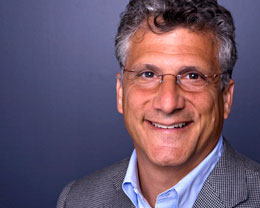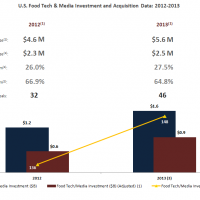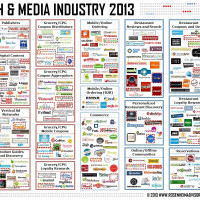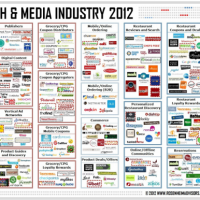[This interview is part of a monthly series of interviews with leading food and technology investors. Be sure to check out last month’s interview with Ali Partovi.]
Physic Ventures co-founder and Managing Director William Rosenzweig says the future is personalized food and health. The venture capital firm plans to invest in and support five to eight entrepreneurs at the intersection of food, health, and technology.
An early pioneer in the health food space as the founder of The Republic of Tea and later of Odwalla, Rosenzweig is no stranger to understanding the innovation trajectory. His firm did a deep dive into the food and tech world this past summer exploring the “universe of innovation in this space.” Wharton MBA intern Ella Merjanova identified 120 companies working in different stages or facets of what they term “food at home,” to help Physic become clear about what ventures will succeed.
Rosenzweig says we are at the beginning of the innovation wave for this sector and sees significant business opportunities for better curated educational content around food, personalized food discovery, and disruptions in the fundamental ways people make decisions about cooking at home
He cautions that many of the early ventures have focused on building cool apps, rather than solving actual problems. Physic is looking to invest in disruptive technologies, leveraging their network of relationships with large companies to help entrepreneurs succeed more rapidly.
If you’re developing a game-changing technology and hoping for investment from Physic, says Rosenzweig, your team needs vision, pragmatic experience to execute, a clear idea about strategic choices related to potential business models, competitive advantage, capital efficiency, and to be committed to collaboration.
Read our interview below…
_____________
Danielle Gould: How did you get interested in the food and tech space?
William Rosenzweig: I’ve had experience in both fields. My first corporate job out of college was working for a technology company called Nakamichi, a Japanese audio company that invented the cassette deck and advanced technology in the audio industry. In the latter part of my twenties I decided to start a tea company called The Republic of Tea, born out of the frustration of feeling like I couldn’t get tea in the United States. As an entrepreneur I tried to reinvent high quality tea for a new audience and the timing was very good, starting in 1990, because there was a confluence of several key trends in the US market. One was that the natural food movement was just beginning. Along with that Whole Foods was starting to become a national distribution channel for high quality, natural and gourmet products. So we swept a wave that was both taste, culture and market, and grew very quickly.
Since then I’ve been very interested in building companies and working as both an entrepreneur and as an investor. Any venture that is going to have some kind of rapid scale dynamic, which is what’s attractive to venture investing, is likely to have some kind of enabling technology at its heart. Whether it’s the product itself or whether it’s the platform [mobile and social media] in which the product exists. And I think that’s what is so exciting right now to see the work that you’re covering, the food and tech renaissance and all the entrepreneurs that I’m getting to know now who are combining passions for both food and technology in new ways.
DG: Where do you see the large opportunities for growth in this space right now?
WR: I think there are a lot of different niches, particularly in the food business where it’s always been a matter of individual tastes, that are exciting. I want to be careful not to minimize or denigrate any idea that is not necessarily a billion dollar idea, but it’s also very important for an entrepreneur to be realistic about what the size of an opportunity might be, as well as the right size of investment and effort.
What’s happening now that is a little dangerous is that people are raising a lot of money for opportunities that are probably fairly niche in scope. I encourage entrepreneurs to focus on capital efficiency, particularly at the very beginning. Once they have a strong proof of concept, then they should raise more capital to scale. And the best entrepreneurs do that.
One of the areas I think is most exciting now in the food and tech area is certainly educational content. We’re migrating from the static food network, half-hour show of Ina Garten teaching you what she wants to teach you that day, to highly personalized content and delivery on mobile devices and iPads. Having the content that matches your personal interests when and where you need it is a huge opportunity. Companies like Rouxbe and Culinapp and similar folks are just starting to, I think, scratch the surface. The Callaway guys with the Martha Stewart cookies are another example.
Another area I that think is going to be really big is food discovery and personalization through network referral. Food Spotting is onto this. Yelp and OpenTable do it a little bit. But better ways to discover, vet and choose, maybe even actually transact, are going to be a big area open for disruption. A lot of the solutions we see these days offer a piece of this, but not necessarily a comprehensive platform. It will be interesting to see who’s able to conceive a truly comprehensive platform that delivers real value and has a monetizable business model.
Another area we are particularly excited about is the whole decision infrastructure for cooking at home. Given continued pressure on discretionary spending, movement toward health and personalized experience, and increased desire for covering the social dynamics of dining together, the kinds of companies that help you make decisions about what, when, and how to cook while curating that content or enabling you to personalize your own interests very efficiently are going to be exciting. Companies like Yummly, Cookstr, and Foodily are doing things like this. It’s going to be very interesting to see how the landscape between large incumbents in the publishing business like Recipe.com, Emeritus, and Conde Nast fair relative to entrepreneurs who are creating more disruptive business models.
One of the things we are studying very carefully is the incumbent’s role relative to the entrepreneur’s role, and even figuring out where there may be opportunities. One of the things we do at Physic Ventures is to look to our network of relationships, and we work with some very big companies, to figure out how we might be able to borrow or apply resources or insights or expertise from some of those big companies to accelerate the disruptive path of entrepreneurial companies. Maintaining their independence, but creating innovative partnerships.
DG: Could you talk about some of the problems you would like to see solved that you haven’t seen tackled?
WR: An area that we’re interested in is the convergence of food, fitness and health. There are a lot of food apps and there are a lot of fitness apps, companies, and approaches, but we haven’t really seen a compelling integrated solution yet. On the nutrition and diet front, linking lifestyle to life science or health systems is something we’re keenly interested in that we haven’t seen anybody really bring a lot of work to yet.
Do you know what Kaiser Permanente is? It’s a big healthcare provider system, integrated health system that does a lot of prevention and wellness. So how do you make Lose It credible and useful not only to the individual who’s trying to manage their weight, but also credible and useful to a health system that at some point is going to determine your insurance rate based on your personal behaviors?
There are two things I’m concerned about in the food and tech space. One is there’s a lot of solutions that are in search of a market, meaning people come up with an idea and it’s sort of like oh, isn’t it cool that we can do this?
This is not uncommon at the very early stages of waves on innovation, but it is something that I think is maybe one of your jobs, to help to impose the rigor with the entrepreneurs to think about what need are you really solving for here? Not just coming up with a cool app.
The other risk is that wherever there’s a high amount of idealism there can be a tendency to have tension with pragmatism. You get people who are excited about something and they’re so passionate about it that they either haven’t built their team in a way where they’re bringing the kind of rigor and expertise that they need or they’ve just fallen in love with their own idea. I saw this with social entrepreneurship, and I’ve seen it with social impact and corporate social responsibility. So I always encourage entrepreneurs to maintain their passion, but also maintain their pragmatism. I like to call it :walking the visionary path with practical feet” and managing that creative tension.
DG: What kinds of criteria are you considering when evaluating potential investments in the space? Does the criteria for food tech startups differ from investments in more traditional tech companies?
WR: I don’t think so. It’s a great question and it’s one I asked myself going into this exploration – is this food segment going to be different in some way? At the end of the day from a venture capital investment perspective, it’s not. In our case, we are managing institutional funds that have a high expectation for return. We are looking for really big markets and we are looking to get in at a time where there is leverage to obtain scale.
The things we look for are, first and foremost, a team that has the vision and experience to execute. Usually that capability to execute is wrapped around a number of prior experiences, where they learned a lot, which accelerates their ability to be successful now. One of the weaknesses in the food area is that you have a lot of people who love food and while they did something in technology before, it’s not really applicable and doesn’t really add competitive advantage to their current food-related venture.
We are looking for leaders who have a clear idea about the strategic choices they’re going to make to get from here to there, and at what time it’s appropriate to identify a business model and test that business model. We are prepared to invest before there’s a clear business model, but we would like to at least understand or be aligned with the team about what those possible business models are and what their pros and cons might be. For instance, when we invested in GoodGuide.com, we didn’t have a clear business model yet, but we had an idea for six different approaches and we had benchmarks in other industries where big successful companies had been built with certain attributes of that business model.
The third thing we look for is some kind of proprietary IP or technology, or competitive advantage that’s not easily replicable, that puts up a barrier to entry, a quick barrier to entry that’s really meaningful. And again, this is something that I think is quite difficult for a lot of the food and tech companies to really bring us.
Having a capital efficient strategy, being able to prove your concept quickly and affordably is also something we really look for. One of the things I really like to talk to entrepreneurs about is what is proof of concept to you? Is it 8 of your friends using your product once, or is it 8,000 people using it and you demonstrating that you can get 8,000 people to use it regularly, only spending 10 cents per person acquiring them as a customer.
I like people who think in terms of quantifiable metrics and indicators of scale. We see maybe 1,400 business plans that fit our scope a year and we probably make 5 or 6 investments. We are very upfront with people – ‘this is certainly something we’re interested in, but it’s highly unlikely we’d be able to invest at this stage. Why don’t you go do this, this and that and keep us posted. And if we can be helpful…” So, it’s more about a relationship than a transaction. My advice to entrepreneurs is to develop relationships early and demonstrate that you do what you say you’re going to do, and you demonstrate that you learn quickly, and that you really understand focus and impact
If you add up those 3-4 things I just spelled out the best in class company is going to have all of those. From an investor perspective, we would be looking for one that has all of these things.
And then the fifth thing I think we particularly look for, and I don’t know if this goes for general rule of thumb, but we really like collaborative teams. We look for entrepreneurial teams that are also open to partnering and collaborating and feel like they’re going to benefit.
DG: Do you have a target IRR? If so, what is it?
WR: We don’t think about things like that at all. We think about creating great companies. And great companies that come to life at the right time and create a new category are going to be rewarded — either by the public markets or through strategic acquisition. Our aspiration is to build the greatest company in the space.
DG: Are you looking to invest in food tech startups or have you already identified the companies you’re interested in investing in? If you are interested, how do you like to be approached?
WR: We’re approached by dozens of people a week. We like to develop relationships before people need capital and before it becomes transactional, where it is more relationship based. I’m in conversation right now with 7 or 8 different folks in the food space. My partner, Andy, is in conversation right with 3 or 4 companies that are in the quantified-self area. And quantified self and food and tech like I said earlier, are going to converge at some point.
We like entrepreneurs that have done their homework – both on us and determined that we’d be a good fit, and have done some really good work on their own in terms of their business plan. Right now, it’s funny, there’s a lot of emphasis on the pitch deck. I see a lot of pitch decks that are really long on concept and really short on strategy or plan or tactics. Like okay, here’s the idea, so I get a lot of decks that are here’s the big idea and I think that’s really nice. And people are getting really good at making very nice looking, compelling decks because there’s a lot of demo action right now you know?
I just got a deck this morning. I met the entrepreneurs at 500 Startups. I thought they were really nice and I think they’re really passionate and then they said here’s our deck. And I read through the deck and it was just all concept and there was no plan. So I had to write them back and say please send me your plan for implementation. What’s going to make you guys uniquely capable of executing this? What gives you guys the confidence and the mojo that you’re going to be able to execute on this idea? Because everybody can have the idea and it’s a nice idea, but what makes you uniquely qualified? So I’m looking for what’s the unique qualification, where’s the unique competitive advantage and what’s so special about your strategy that is going to make you likely to succeed? And there’s not frankly a lot that is proprietary in this whole food and tech area, so people have to kind of get over that you know, and they have to work harder.
DG: Why don’t you think there are many proprietary opportunities?
WR: Well, unless you’re creating a new gene for a new pear or something that you’re going to propagate, there’s not a lot of competitive advantages that little entrepreneurs have at making a new food that Unilever or Pepsi doesn’t have. And there’s not a lot of search capability that a startup has that Google doesn’t have.
You may come in and tell me well, Google is not focused on this and I might agree with you, but then you need to tell me, why is your team going to be able to out-Google Google when they’re asleep at the wheel. You still need a compelling approach, strategy.
DG: That’s great advice. How many investments are you looking to making in this space over the next five years?
WR: Between five and eight company relationships over the next five years.







